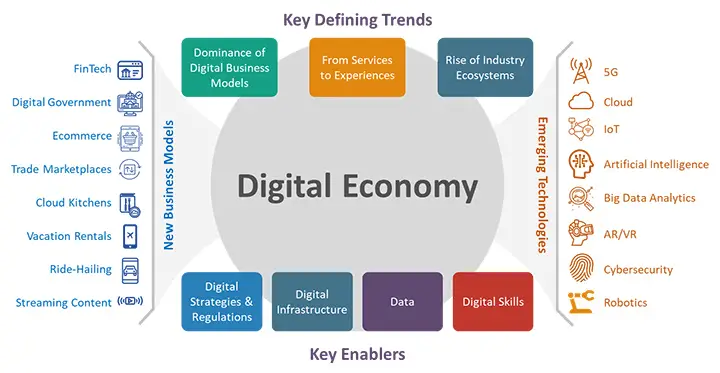The Growing Importance of CDN in the Digital Economy

In the rapidly evolving digital landscape, Content Delivery Networks (CDNs) have emerged as essential infrastructure for delivering seamless and high-quality online experiences. Here are the key reasons for their growing importance:

1. Booming Online Content Demand:
The explosion of streaming services, social media usage, and e-commerce has led to a surge in demand for online content. CDNs enable content providers to deliver this content quickly and efficiently to users worldwide.
2. Geographic Distribution of Content:
As global internet usage continues to rise, it becomes increasingly important to distribute content close to users. CDNs establish servers in multiple locations, reducing latency and improving user experience.
3. Enhanced Quality of Service:
CDNs implement various techniques, including caching, bandwidth optimization, and load balancing, to ensure consistent and reliable delivery of content. This improves video streaming quality, reduces website loading times, and enhances user satisfaction.
4. Security and Scalability:
CDNs provide robust security measures to protect content from unauthorized access and attacks. They also offer scalable infrastructure that can handle peak traffic periods without compromising performance.
5. Cost Optimization:
By caching content closer to users, CDNs reduce network congestion and bandwidth usage, resulting in cost savings for content providers. This makes CDNs an affordable solution for businesses of all sizes.
6. Mobile and IoT Connectivity:
With the increasing penetration of mobile devices and the Internet of Things (IoT), CDNs are essential for delivering content to these devices. They optimize content for different screen sizes and connectivity speeds.
7. Enhanced User Experience:
Fast and reliable content delivery leads to a superior user experience. Reduced loading times, smooth streaming, and error-free downloads create a positive impression on users.
8. Competitive Advantage:
In today’s fast-paced digital market, businesses that provide seamless online experiences gain a competitive advantage. CDNs empower businesses to meet and exceed user expectations.
Conclusion:

CDNs have become indispensable for businesses and users alike in the digital economy. They enable the efficient delivery of high-quality content, enhance user experience, and provide the scalability and security required for a thriving online ecosystem. As the digital landscape continues to evolve, the role of CDNs will only grow in importance.## The Growing Importance Of Cdn In The Digital Economy
Executive Summary
Content Delivery Networks (CDNs) have become increasingly important in the digital economy. They provide a number of benefits to businesses, including improved website performance, reduced latency, and increased security. As the digital economy continues to grow, CDNs will play an increasingly important role in delivering content to users around the world.
Introduction
A CDN is a distributed network of servers that deliver content to users based on their location. This means that users can access content from the server that is closest to them, which reduces latency and improves website performance. CDNs can also help to improve security by protecting websites from DDoS attacks and other threats.
FAQs
1. What are the benefits of using a CDN?
- Improved website performance: CDNs can reduce latency and improve website performance by delivering content from the server that is closest to the user.
- Reduced latency: Latency is the time it takes for data to travel from the server to the user’s device. CDNs can reduce latency by delivering content from the server that is closest to the user.
- Increased security: CDNs can help to improve security by protecting websites from DDoS attacks and other threats.
2. How do CDNs work?
CDNs work by storing copies of content on servers around the world. When a user requests content from a website, the CDN will deliver the content from the server that is closest to the user. This reduces latency and improves website performance.
3. What are the different types of CDNs?
There are two main types of CDNs:
- Pull CDNs: Pull CDNs store copies of content on edge servers around the world. When a user requests content from a website, the CDN will pull the content from the edge server that is closest to the user.
- Push CDNs: Push CDNs store copies of content on origin servers around the world. When a user requests content from a website, the CDN will push the content from the origin server to the edge server that is closest to the user.
Subtopics
1. Content Delivery
Content delivery is the process of delivering content to users over the internet. A CDN can improve content delivery by reducing latency and improving website performance. CDNs can also help to improve security by protecting websites from DDoS attacks and other threats.
- Edge servers: Edge servers are located in close proximity to users, which reduces latency and improves website performance.
- Content caching: CDNs cache content on edge servers, which reduces the time it takes to deliver content to users.
- Load balancing: CDNs can load balance traffic across multiple servers, which helps to improve website performance.
2. Security
A CDN can help to improve security by protecting websites from DDoS attacks and other threats. CDNs can also help to protect websites from data breaches and other security risks.
- DDoS protection: CDNs can protect websites from DDoS attacks by absorbing and dispersing attack traffic.
- Web application firewall (WAF): A WAF can help to protect websites from data breaches and other security risks.
- SSL/TLS encryption: SSL/TLS encryption helps to protect data in transit between the CDN and the user’s device.
3. Performance
A CDN can improve website performance by reducing latency and improving content delivery. CDNs can also help to improve website performance by reducing the load on the origin server.
- Latency reduction: CDNs can reduce latency by delivering content from the server that is closest to the user.
- Content caching: CDNs cache content on edge servers, which reduces the time it takes to deliver content to users.
- Load balancing: CDNs can load balance traffic across multiple servers, which helps to improve website performance.
4. Scalability
A CDN can help to improve scalability by distributing content across multiple servers. This helps to reduce the load on the origin server and improves website performance.
- Edge servers: Edge servers are located in close proximity to users, which helps to improve scalability.
- Content caching: CDNs cache content on edge servers, which reduces the load on the origin server.
- Load balancing: CDNs can load balance traffic across multiple servers, which helps to improve scalability.
5. Cost-effectiveness
A CDN can help to improve cost-effectiveness by reducing the load on the origin server. This can help to reduce hosting costs and improve website performance.
- Reduced hosting costs: CDNs can help to reduce hosting costs by reducing the load on the origin server.
- Improved website performance: CDNs can improve website performance by reducing latency and improving content delivery.
- Increased revenue: CDNs can help to increase revenue by improving website performance and reducing hosting costs.
Conclusion
CDNs are an essential part of the digital economy. They provide a number of benefits to businesses, including improved website performance, reduced latency, and increased security. As the digital economy continues to grow, CDNs will play an increasingly important role in delivering content to users around the world.
Relevant Keyword Tags
- CDN
- Content Delivery Network
- Website Performance
- Latency
- Security
